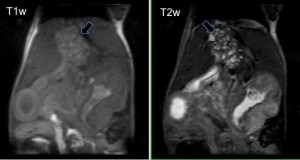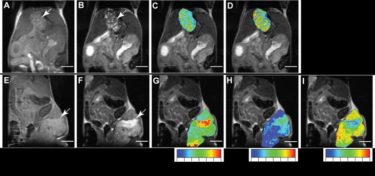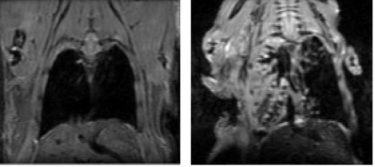Collaborators
Among the group of users, we have active projects in:
- cardiac metabolism (Dr. Rong Tian)
- skeletal muscle metabolism and energetics (Drs. David Marcinek)
- aged muscle studies (Drs. David Marcinek and Peter Rabinovitch)
- mouse brain imaging, cancer imaging and skeletal/cardiac muscle imaging (Dr. Donghoon Lee)
Please contact us to find out how we can help you with your research.
Examples of Images Generated from the NMR Facility

T1-weighted transverse cross-sections displaying mouse anatomy from pelvis to head as well as a coronal image of a mouse brain.
Images acquired by Peter Chiarelli and Richard Revia.

T2-weighted coronal and sagittal images (left and middle columns, respectively) as well as T2*-weighted images (right column) of mice brains 1.5 hours (top row) and 9 hours (bottom row) after injection of iron-oxide nanoparticles.
Images acquired by Peter Chiarelli and Richard Revia.

Fractional Anisotropy (FA) images acquired with the Diffusion Tensor Imaging (DTI) sequence show that 3xTg-AD mice have decreased white matter integrity at 10-12 weeks.
Images acquired by Donna Cross, Marcella Cline, Bradley Neel, and Greg Garwin.

T1-weighted (left) and T2-weighted images of tumor (arrows) in transgenic mouse model of pancreatic ductal adenocarcinoma.
Images acquired by Donghoon Lee and Joshua Park.

Multi-parametric imaging of pancreatic ductal adenocarcinoma in a transgenic KPC mouse (A, B, C, and D) and in a xenograft tumor mouse (E, F, G, H, and I). A and E: T1-weighted. B and F: T2-weighted. C and G: Quantitative T2 map. D and H: Apparent diffusion coefficient map. I: Magnetization transfer image.
Images acquired by Donghoon Lee and Joshua Park.

Images of NIH Swiss mice treated (right) and untreated (left) with the chemical NTCU for 6 months. Lesions observed in the MRI images in treated animals correspond to atypical hyperplasia and squamous cell carcinoma in the histological analysis of the lung.
Images acquired by Laura Riolobos Santamaria.
Publications
The 14T HRIM Facility was utilized to complete studies in the following publications:
2018
Vohra, R., Park, J., Wang, Y., Gravelle, K., Whang, S., Hwang, J., and Lee, D. Evaluation of pancreatic tumor development in KPC mice using multi-parametric MRI. Cancer Imaging (2018) in press.
Park, J., Vohra, R., Klussmann, T., Bengtsson, N.E., Chamberlain, J.S., and Lee, D. Non-invasive tracking of disease progression in young dystrophic muscles using multi-parametric MRI at 14T. PLoS One (2018) in press.
2017
Farr, N., Wang, Y., D’Andrea, S., Gravelle, K.M., Hwang, J.H., and Lee, D. Non-invasive characterization of pancreatic tumor mouse models using magnetic resonance imaging. Cancer Medicine 6, 1082 (2017).
2016
Xu, J., Ypma, M., Chiarelli, P.A., Park, J., Ellenbogen, R.G., Stayton, P.S., Mourad, P.D., Lee, D., Convertine, A.J, and Kievit, F.M. Theranostic Oxygen Reactive Polymers for Treatment of Traumatic Brain Injury. Advanced Functional Materials 26, 4124-4133 (2016).
Qiu, L., Zhang, F., Shi, Y., Bai, Z., Wang, J., Li, Y., Lee, D., Ingraham, C., Feng, X., and Yang, X. Gliomas: Motexafin Gadolinium enhanced Molecular MR Imaging and Optical Imaging for Potential Intraoperative Delineation of Tumor Margins. Radiology 279(2), 400-9 (2016).
2015
Kolwicz, S.C., Liu, L., Goldberg, I.J., and Tian, R. Enhancing cardiac triacylglycerol metabolism improves recovery from ischemic stress. Diabetes, 64(8):2817-27, 2015.
Park, J., Wicki, J., Chamberlain, J., and Lee, D. Multi-parametric MRI at 14T for muscular dystrophy mice treated with AAV vector-mediated gene therapy. PLoS One 10, e0124914 (2015).
2014
Karamanlidis, G., Garcia-Menendez, L., Kolwicz, S.C., Lee, C.F., and Tian, R. Promoting PGC1α-driven mitochondrial biogenesis is detrimental in pressure overloaded mouse hearts. American Journal of Physiology Heart and Circulatory Physiology, 307(9):H1307-16, 2014.
Kim, M., Hunter, R.W., Garcia-Menendez, L., Gong, G., Yang, Y.Y., Kolwicz, S.C., Xu, J., Wang, W., Sakamoto, K., Tian, R. Mutation in the γ2-subunit of AMPK stimulates cardiomyocyte proliferation and hypertrophy independent of glycogen storage. Circulation Research, 114(6):966-75, 2014.
Yu Q, Lee CF, Wang W, Karamanlidis G, Kuroda J, Matsushima S, Sadoshima J, Tian R. Elimination of NADPH oxidase activity promotes reductive stress and sensitizes the heart to ischemic injury. J Am Heart Assoc, 3(1):e000555, 2014.
Berkseth, K.E, Guyenet, S.J., Melhorn, S., Lee, D., Thaler, J.P., Schur, E.A., and Schwartz, M.W. Hypothalamic gliosis associated with high fat diet feeding is reversible in mice: a combined immunohistochemical and magnetic resonance imaging study. Endocrinology 155, 2858-2867 (2014).
2013
Karamanlidis, G., Lee, C.F., Garcia-Menendez, L., Kolwicz, S.C., Suthammarak, W., Gong, G., Sedensky, M.M., Morgan, P.G., Wang, W., and Tian, R. Mitochondrial complex I deficiency increases protein acetylation and accelerates heart failure. Cell Metabolism, 18(2):239-250, 2013.
Garcia-Menendez, L., Karamanlidis, G., Kolwicz S.C., and Tian R. Substrain specific response to cardiac pressure overload in C57BL/6 mice. American Journal of Physiology Heart and Circulatory Physiology, 305: H397-H402, 2013.
Nowakowski, S.G.* and Kolwicz, S.C.*, Korte, F.S., Luo, Z., Robinson-Hamm, J.N., Page, J.L., Brozovich, F.V., Weiss, R.S., Tian, R., Murry, C.E., and Regnier, M. Transgenic overexpression of ribonucleotide reductase improves cardiac performance. Proceedings of the National Academy of the Sciences USA, 110(15): 6187-6192, 2013. *Equal contribution for first author
Lee, D., Thaler, J.P., Berkseth, K., Melhorn, S.J., Schwartz M.W., and Schur, E.A. Longer T2 relaxation time is a marker of hypothalamic gliosis in mice with diet-induced obesity. American Journal of Physiology – Endocrinology and Metabolism 304, E1245-E1250 (2013).
Zhang, T., Zhang, F., Meng, Y., Wang, H., Le, T., Wei, B., Lee, D., Willis, P., Shen B., and Yang, X. Diffusion-weighted MRI monitoring of pancreatic cancer response to radiofrequency heat-enhanced intratumor chemotherapy. NMR in Biomedicine 26, 1762-7 (2013).
We kindly ask all users to acknowledge the facility grant in their publications using the following statement: This work was supported by the NIH Biomedical Research Support Shared Instrumentation Grant (S10RR029021 to 14T HRIM Facility).